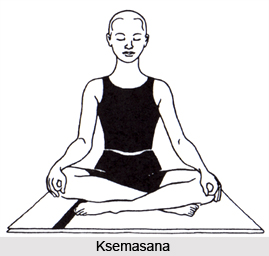Ksemasana, a meditative asana, denotes the posture of sitting cross-legged. This is not an individual asana, but a derivative of Sukhasana which means to sit comfortably.
 Meaning of Ksemasana
Meaning of Ksemasana
The term `Ksema` caters to various meanings in Sanskrit including prosperity, comfort, ease and happiness. Thus, Ksemasana may perhaps translate to a posture that confers these virtues, or the posture of those who possess these qualities.
Yoga Texts and Ksemasana
Few yoga texts mention the Ksemasana, except modern yoga manuals. This is understandable as it is essentially a variation on the Sukhasana, which is itself a comparatively recent addition to the yoga postures, mentioned first in two yoga Upanishads, the Darshanopanishad and Trisikhibrahmanopanishad. These texts do not specify any posture as a Sukhasana but merely state that a pose bringing courage and comfort, is a Sukhasana.
The Sri Tattva Nidhi, a later Hindu text (Ca. 19th century CE) does describe the Sukhasana, and the modern Ksemasana, is a variation only on the posture described in the Sri Tattva Nidhi.
Practice of Ksemasana
While practicing Sukhasana, when the hands are resting on the thighs near the groin, with the palms down and the body held erect, it is known as Ksemasana.
Effects of Ksemasana
Ksemasana confers much the same benefits as those offered by the Sukhasana. Sukhasana offers spiritual advantages so is Ksemasana.
This article is a stub. You can enrich by adding more information to it. Send your Write Up to content@indianetzone.com




















